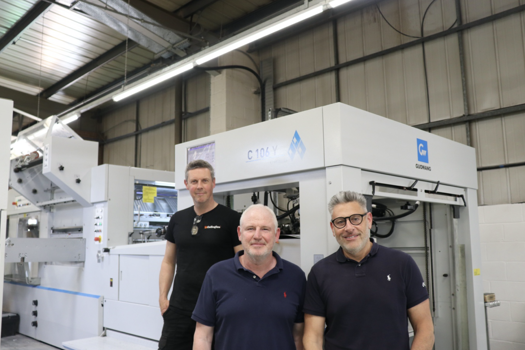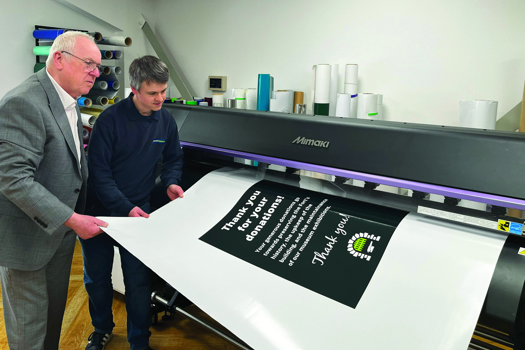This work typically ranged from greetings cards and labels, through to interiors, packaging and direct mail – and many other bits of printed collateral in-between.
However, over the past few years this once niche area has started to become a little bit more mainstream with a number of commercial printers investing in laser cutting technology to give themselves an edge over their competition.
Graham Moorby, joint managing director at Printers Superstore, which supplies Hans Gronhi laser cutting machines, says the main criteria for people bringing this sort of finishing work in-house is if they handle a lot of intricate print jobs or short-run work.
“At the moment it tends to be a niche type customer with a specific need to do a certain sort of work,” says Moorby. “Special finishes tend to generate special prices so the people buying these machines tend to be quite savvy in terms of business and the industry in general, because the level of finishing that these machines offers can generate good revenue for early adopters.”
Although this part of the market appears to be gaining momentum, there is a fairly small pool of companies who currently manufacture laser cutters. The leading players are SEI, LasX, Trotec, Highcon, Blackman & White and Motioncutter.
The latter company got into the market more by accident than choice. “We made a machine for our own print house in Germany because we wanted to do more general commercial finishing,” explains Shaun Stanley, global sales director at Motioncutter. “When people saw what the machine could do they asked if they could buy one off us. So we became manufacturers and our print shop in Germany is now also used as a demo centre.”
Stanley says that Motioncutter’s sheetfed laser cutting system has been sold around the globe – including one to Mongolia – with 10 installations in the UK to date. He adds that the big shift in terms of advances in laser cutting technology has been around the degree of automation manufacturers offer.
“We’ve got a fully automated system,” explains Stanley. “The paper goes onto a pile feeder and the machine reads the cut file and it will cut it to the specifications of the paper, strip it and give you a finished product at the end.”
Likewise, the Hans Gronhi LC series machines supplied by Printers Superstore, which include a sheetfed laser cutter and a roll-to-roll laser cutting solution for label printers, are also fully automated, according to Moorby.
“This sort of finishing process was one of the last to go digitised,” says Moorby. “All the operator has to do is download the job onto the machine and away you go.”
He adds that the company has recently noticed growing interest from printers attracted by the machine’s versatility and ability to add value to a piece of print.
“People should really spend some time looking at this sort of product. There are lots of companies out there that would really benefit from having something like this because of the wide variety of different work they could produce. You can finish laminated sheets, encapsulated sheets, plastics – it opens up a whole new range of possibilities for people,” concludes Moorby.
Case study: PaperShapers
Based in Edmonton, north London, over the past 25 years PaperShapers has continually invested in specialist paper cutting technology. Today, PaperShapers has three laser cutters in its armoury of machines and owner Colin Metson says this enables the firm “to say ‘yes’ to many more jobs we would have previously turned away”.
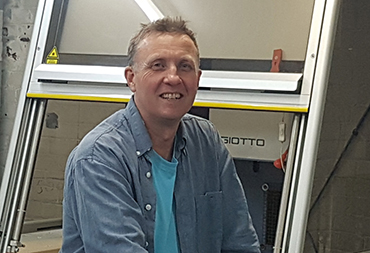 The family-run business offers its cutting service to print, design and manufacturing industries and the products it produces range from simple inserts and packaging pieces through to highly complex 3D structures. “Our typical day involves advising on weird and wonderful shapes,” says Metson.
The family-run business offers its cutting service to print, design and manufacturing industries and the products it produces range from simple inserts and packaging pieces through to highly complex 3D structures. “Our typical day involves advising on weird and wonderful shapes,” says Metson.
He adds that many print companies use PaperShapers’ services and expertise, to “enhance their offerings to clients” who are demanding much more from their printed messaging.
“Creatives like to incorporate intriguing shapes on brochure covers and invitations to highlight the tangible advantages of print. We are also able to laser kiss-cut adhesive labels where laser power is adjusted to cut part way through the sheet.”
PaperShapers’ first laser cutting machine was a B2 flatbed plotter laser manufactured by Trotec called the Speedy 300, which is still occasionally used for short-run laser engraving or acrylic jobs. However, today most of the company’s work is processed on its two high-speed Galvo lasers – the Flexi 500 and 600 manufactured by SEI – which were installed in 2011 and 2015.
“Dynamic mirrors are moved by galvanometer drives,” explains Metson. “The mirrors are lightweight and can oscillate at extreme speeds enabling the cutting beam to move up to 10 times the speed of traditional plotter systems, still maintaining high precision. Our machines can process up to a B1 sheet size. Three different focus depths are available as is the facility of a moving table. This gives a very flexible range of laser spot size and cutting area. Setup is straightforward as the cutting software follows a vector path.”
And because tooling is not required this means that adjustments can be made during production.
Metson says that, as the company turns out several different jobs each day, speed of setup is key. “We have developed a quick, effective routine which includes laser cutting a bespoke template for each job ensuring cutting areas are not resting on any surface that could create burn marks from the laser flashback. Sheet registration is also guaranteed by fixing lay stops on the grip and lay edges,” he adds.
At PaperShapers typical run lengths are 500 units and the two high-speed lasers are capable of running 5,000 sheets or more per day. One of the challenges that users of laser cutter technology need to get to grips with is the potential issue of burnt edges. “Clients have been put off with previous experiences of poor laser cutting, but with the correct choice of substrate we are able to eliminate any visual burn marks,” says Metson.
He says the best materials for laser cutting are quality uncoated paper and board. Coated or laminated materials can be laser cut, but “if your design is busy some ‘smoke milking’ may occur”. There is no maximum cutting thickness, but generally speaking the thicker the material the more power is required and therefore there is potentially going to be more burn.
“Conversely a light material under 170gsm requires very little power and therefore burn is invisible. Our rule of thumb is space between cuts at five times the thickness of material. So a 170gsm paper for example can be more intricate than a 340gsm paper,” explains Metson.
Since splashing out on laser cutting technology, Metson says the company hasn’t looked back. “Our laser cutting offering has enabled PaperShapers to enter new markets and as technology increases speed viability of laser cutting is becoming more common. We are always keeping an eye out for the latest developments – robotics is likely to be on our shopping list with our next investment.”
Case study: Laser Bureau
Laser Bureau specialises in laser cutting paper. The company, which is based in Sharnbrook, Befordshire, and has a sister business called Cutture, based in London, can engrave, perforate and namecut – it also offers a hand finishing service. According to Laser Bureau managing director, Chris Demott, the company’s “eye is always on quality”. This quest to be the best is reflected in the company’s client list, which includes the likes of Harrods, Molton Brown and Ferrari.
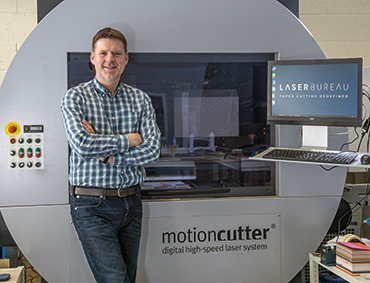 “Our work is varied which is a really exciting challenge; we can go from making large-scale pieces for point-of-sale and exhibitions, to intricate tags and place cards for events,” says Demott.
“Our work is varied which is a really exciting challenge; we can go from making large-scale pieces for point-of-sale and exhibitions, to intricate tags and place cards for events,” says Demott.
He adds that the company receives more and more requests to laser cut elements for packaging – and particularly luxury cartons that require that little bit of extra flair to set products apart from the competition. Another growing area of business is brochures and book covers. Demott says that as these get more creative “laser cutting is now a viable option due to the higher volumes we can now produce with our equipment”.
Laser Bureau uses two different types of laser cutter. “We have cabinet lasers from Trotec – these are laser plotters,” says Demott. “The cabinet lasers are really flexible and although we specialise in cutting paper and card they will happily cut and engrave other materials like acrylic and wood.”
More recently the company has invested in a high-speed digital Galvo laser cutter sold by Motioncutter, which is significantly quicker than the Trotecs, according to Demott.
“The Motioncutter is ideal for cutting paper and card and the control you have to refine your cut is amazing. As the name suggests they also cut in motion, so with a traditional feeder you can load in a pallet of paper and, using either sheet or print detection, laser cut much larger volumes than previously possible because you don’t need to hand feed.”
He adds that a key attraction of the Motioncutter is how relatively straightforward it is to incorporate numbering and personalisation into laser cut designs. “Every invitation or magazine cover, for instance, can now have a guest’s or client’s name cut out, that really has the wow factor,” explains Demott. “Another feature of laser cutters that are probably the most under utilised and the thing that still surprises me every time we do it is you can laser kiss cut. We produce adhesive-backed labels for some clients and the complexity of cut is impressive, but the fact that you can adjust the laser so it doesn’t cut all the way through the backing sheet makes them really easy to peel and apply.”
He adds that in addition to cutting the company also offers alternatives to other finishes – for example, adding a laser crease or perforation. “It means we are becoming an option for short run work that would usually be die-cut, saving on tooling costs. You can also push the designs further than you can with die-cutting, adding extra detail or text that would normally not be possible with a forme.”
Demott says there are lots of different options when it comes to laser cutting technology and the investment outlay need not be huge – especially if someone wants to use the equipment for prototyping or very short-run work.
“The thing to remember is many businesses choose to work with a specialist laser cutting service because ultimately it involves cutting paper with fire. To do this safely requires specialist knowledge and training. To do it quickly and as cleanly as possible requires a much larger investment in equipment,” says Demott.
Case study: Graphica Display
Graphica Display was founded in 2007 and since its creation has provided a wide range of display and signage for clients including Axa Group, Lacoste and Specsavers. The business started out specialising in commercial interiors – signage, graphics, lightboxes and fabrics – and slowly branched out into other areas, including events and exhibitions.
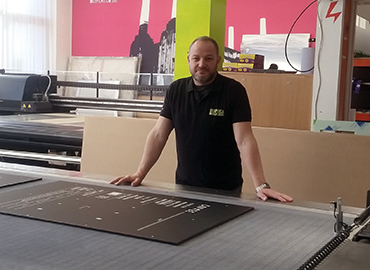 In 2010, the company set up a production facility in Chessington, Surrey, running Mimaki presses. The set up worked so well that in 2015 it almost doubled the amount of space it occupied when it moved to new 600m² premises.
In 2010, the company set up a production facility in Chessington, Surrey, running Mimaki presses. The set up worked so well that in 2015 it almost doubled the amount of space it occupied when it moved to new 600m² premises.
At the same time the company invested circa £500,000 in two new pieces of kit – a six-colour Agfa Jeti Mira UV-inkjet flatbed printer, the first machine of its type to be installed in the UK, and a Blackman & White laser cutter.
“We looked at similar machines in the market, but we couldn’t find one that does what the Blackman & White does,” says Rob White, production director at Graphica. “The main reason we went for it was because the flatbed was good – it was 2x3m – and also there is a detachable laser head on it which is fantastic for acrylics.”
White says that prior to splashing out on the machine the company
was sending all of its laser cutting work out to specialist suppliers. This was both time consuming and also costly. But what the company did – as it has always done in the past prior to making investments – is it established that a market for laser cutting was there before it finally took the plunge and signed up for the Blackman & White.
“We basically started off in trade buying because you can work out who you are dealing with and what customers you’ve got and then you can buy the machinery that is applicable to your needs,” says White. “That’s the business ruling that saved us during our early years of trading and during the recession years because we have never bought machinery and then tried to satisfy the market. We’ve done it the other way round. We have satisfied the market and then we have bought machinery to maximise revenue and profit.”
He adds that in addition to saving the company money, the laser cutter has generated additional revenue and won it new customers. And because of the high levels of automation – “you just put it on the conveyor and everything is cut out” – it has also saved the business time.
As for what advice he would offer someone who is currently weighing up investing in this type of technology, White says people need to bear in mind that laser cutters are “big pieces of kit” and they are expensive “so you have got to have the throughput for it. Don’t entertain the idea of buying one on the speculation of getting work. Go out and get the work first and then go out and get your machine”.









